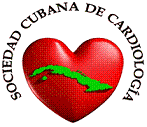Complicaciones no letales en pacientes geriátricos con síndrome coronario agudo con elevación del segmento ST
Texto completo:
PDFResumen
Introducción: En el síndrome coronario agudo, la edad representa una de las variables de riesgo más importantes en cuanto a valor pronóstico se trata. El estudio tiene como objetivos caracterizar la población de pacientes mayores de 65 años con diagnóstico de síndrome coronario agudo con elevación del segmento ST e identificar posibles asociaciones entre la ocurrencia de complicaciones intrahospitalarias no letales y los factores de riesgo cardiovasculares, la topografía del infarto y la fracción de eyección del ventrículo izquierdo.
Métodos: Estudio observacional de corte transversal con componente analítico, de todos los pacientes en edad geriátrica ingresados en la Unidad de Cuidados Coronarios Intensivos del Hospital Docente Clínico-Quirúrgico “Comandante Manuel Fajardo” de La Habana, con síndrome coronario agudo con elevación del segmento ST entre el año 2016 y el 2020.
Resultados: Las mujeres presentaron una elevada incidencia de hipertensión arterial y diabetes mellitus, así como una asociación estadística significativa con la ocurrencia de complicaciones hemodinámicas (77,3 %; p = 0,013) y el infarto de topografía anterior (62,8 %; p = 0,02).
Conclusiones: La presencia de complicaciones cardiovasculares en general se asoció con los antecedentes de hipertensión arterial, el infarto de topografía anterior y, en el caso específico de las complicaciones hemodinámicas, con el sexo femenino y la fracción de eyección del ventrículo izquierdo.
Palabras clave
Referencias
Fondo de Población de Naciones Unidas UNFPA. Envejecimiento en el Siglo XXI: Una celebración un desafío. Resumen Ejecutivo. [acceso 3/3/2022]. Disponible en: http://www.unfpa.or.
Gadó K, Szabo A Markovics D, Virág A. Most common cardiovascular diseases of the elderly – A review article. Developments in Health Sciences. 2022 [acceso 4/4/2022]. Disponible en: https://akjournals.com/view/journals/2066/aop/article-10.1556-2066.2021.00048/article-10.1556-2066.2021.00048.xml.
Zhao Q, Wang L, Kurlansky PA, Schein J, Baser O, Berger JS. Cardiovascular outcomes among elderly patients with heart failure and coronary artery disease and without atrial fibrillation: a retrospective cohort study. BMC Cardiovasc Disord .2019;19(1):19. DOI: https://doi.org/10.1186/s12872-018-0991-1.
Paneni F, Diaz Cañestro C, Libby P, Lüscher TF, Camici GG. The Aging Cardiovascular System: Understanding It at the Cellular and Clinical Levels. J Am Coll Cardiol .2017;69(15):1952-7. DOI: https://doi.org/10.1016/j.jacc.2017.01.064.
Sidney S, Go AS, Jaffe MG, Solomon MD, Ambrosy AP, Rana JS. Association Between Aging of the US Population and Heart Disease Mortality From 2011 to 2017. JAMA Cardiol;4(12):1280-6. DOI: https://doi.org/10.1001/jamacardio.2019.4187.
Dai X, Busby-Whitehead J, Alexander KP. Acute coronary syndrome in the older adults. Journal of geriatric cardiology: J Geriatric Cardiol, 2021;13(2):101-8. DOI: http://doi.org/10.11909/j.issn.1671-5411.2016.02.012.
Thygesen K, Alpert JS, Jaffe AS, Chaitman BR, Bax JJ, Morrow DA, et al. Consenso ESC 2018 sobre la cuarta definición universal del infarto de miocardio. Rev Esp Cardiol .2019;72(1):72: e1-e27. DOI: https://doi.org/10.1016/j.recesp.2018.11.011.
Mohamed NT, Khalil El Desouky AI, Amin El Din GE, Abdul-Rahman SA. Atypical presentation of ischemic heart disease in Egyptian elderly. EJGG.2021 [acceso 20/7/2021];8(2):25-9. Disponible en: https://ejgg.journals.ekb.eg/article_204175_d357fd7cb552b628b8842bf554b635fd.pdf
Wu Q, Zhang D, Zhao Q, Liu L, He Z, Chen Y et al. Effects of transitional health management on adherence and prognosis in elderly patients with acute myocardial infarction in percutaneous coronary intervention: A cluster randomized controlled trial. PLoS ONE. 2019;14(5): e0217535. DOI: https://doi.org/10.1371/journal.pone.0217535.
Ouellet GM, Geda M, Murphy TE, Tsang S, Tinetti ME, Chaudhry SI. Prehospital Delay in Older Adults with Acute Myocardial Infarction: The ComprehenSIVe Evaluation of Risk Factors in Older Patients with Acute Myocardial Infarction Study. J Am Geriatr Soc. 2017;65(11):2391-2396. DOI: https://doi.org/10.1111/jgs.15102.
Dirección de Registros médicos y estadísticas de salud. Anuario Estadístico de Salud 2019. Cuba; 2020. [acceso 23/10/2020]. Disponible en: http://bvscuba.sld.cu/anuario-estadistico-de-cuba/.
Chang AY, Skirbekk VF, Tyrovolas S, Kassebaum NJ, Dieleman JL. Measuring population ageing: an analysis of the Global Burden of Disease Study 2017. Lancet Public Health. 2019; 4(3):e159-e167. DOI: https://doi.org/10.1016/S2468-2667(19)30019-2.
Ghimire K, Dahal R. Geriatric Care Special Needs Assessment. En StatPearls. Treasure Island (FL): StatPearls Publishing. 2022 (acceso 22/2/2022):PMID: 34033334. Disponible en: https://pubmed.ncbi.nlm.nih.gov/34033334/.
Kerola AM, Palomäki A, Rautava P, Nuotio M, Kytö V. Sex Differences in Cardiovascular Outcomes of Older Adults After Myocardial Infarction. J Am Heart Assoc. 2021;10(23):e022883. DOI: https://doi.org/10.1161/JAHA.121.022883.
Fong HK, Desai R, Faisaluddin M, Parekh T, Mahmood A, Shah V et al. Sex disparities in cardiovascular disease outcomes among geriatric patients with prediabetes. Prim Care Diabetes. 2021; 15(1):95-100. DOI: https://doi.org/10.1016/j.pcd.2020.06.005.
The sixth report of the Joint National Committee on prevention, detection, evaluation, and treatment of high blood pressure. Arch Intern Med. 2021;157(21):2413–46. DOI: https://doi.org/10.1001/archinte.157.21.2413.
Shih JY, Chen ZC, Chang HY, Liu YW, Ho CH, Chang WT. Risks of age and sex on clinical outcomes post myocardial infarction. Int J Cardiol Heart Vasc. 2019;23:1003- 50. DOI: https://doi.org/10.1016/j.ijcha.2019.100350.
Richards AM, Nicholls MG, Troughton RW, Lainchbury JG, Elliot J, Frampton C et al. Antecedent hypertension and heart failure after myocardial infarction. J Am Coll Cardiol. 2002;39(7):1182-8. Available in: https://doi.org/10.1016/s0735-1097(02)01737-0.
Berthillot C, Stephan D, Chauvin M, Roul G. In-hospital complications after invasive strategy for the management of Non STEMI: womenj fare as well as men. BMC Cardiovasc Discord. 2010;10:31. DOI: https://doi.org/10.1186//1471-2261-10-31.
Kosuge M, Kimura K, Kojima S, Sakamoto T, Ishihara M, Asada Y et al. Japanese Acute Coronary Syndrome Study (JACSS) Investigators. Sex differences in early mortality of patients undergoing primary stenting for acute myocardial infarction. Circ. 2006;70(3):217-21. DOI: https://doi.org/10.1253/circj.70.217.
Santoro GM, Carrabba N, Migliorini A, Parodi G, Valenti R. Acute heart failure in patients with acute myocardial infarction treated with primary percutaneous coronary intervention. Eur J Heart Fail. 2008;10(8):780-5. DOI: https://doi.org/10.1016/j.ejheart.2008.06.004.
Hochman JS, Buller CE, Sleeper LA, Boland, Dzavik V, Sanborn TA et al. Cardiogenic shock complicating acute myocardial infarction—etiologies, management and outcome: a report from the SHOCK Trial Registry. Should we emergently revascularize Occluded Coronaries for cardiogenic shock? J Am Coll Cardiol. 2000; 36(3) Suppl A):1063-70. DOI: https://doi.org/10.1016/s0735-1097(00)00879-2.
Rakugi H, Yu H, Kamitani A, Nayamura Y, Ohishi M, Kamide K et al. Links between hypertension and myocardial infarction. Am Heart J. 1996 [acceso 10/7/2021] Jul;132(1Pt 2 Su):213-21. PMID: 8677859. Disponible en: https://pubmed.ncbi.nlm.nih.gov/8677859/.
Vogt M, Strauer BE. Systolic ventricular dysfunction and heart failure due to coronary microangiopathy in hypertensive heart disease. Am J Cardiol 1995 [acceso 10/7/2021];76 (2):48D–53D. DOI: https://doi.org/10.1016/S0002-9149(99)80492-5.
Richards AM, Nicholls MG, Troughton RW, Lainchbury JG, Elliot J, Frampton C et al. Antecedent hypertension and heart failure after myocardial infarction. J Am Coll Cardiol. 2002 [acceso 10/7/2021];39(7)1182-8. DOI: https://doi.org/10.1016/s0735(02)01737-0.
Rembek M, Goch A, Goch J. The clinical course of acute ST-elevation myocardial infarction in patients with hypertension. Kardiol Pol. 2010 [acceso 15/7/2021];68(2):157-63. PMID: 20301024. Disponible en: https://pubmed.ncbi.nlm.nih.gov/20301024/.
Maury S. Fracción de eyección del ventrículo izquierdo: Correlación con el tamaño del infarto y la reserva de perfusión miocárdica posinfarto agudo de miocardio. Arch Cardio lMex. 2013 [acceso 15/7/2021];83(supl 3):1-41. Disponible en: https://www.researchgate.net/publication/265078871.
Sutton NR, Li S, Thomas L, Wang TY, de Lemos JA, Enriquez JR et al. The association of left ventricular ejection fraction with clinical outcomes after myocardial infarction: Findings from the Acute Coronary Treatment and Intervention Outcomes Network (ACTION) Registry-Get With the Guidelines (GWTG) Medicare-linked database. Am Heart. 2016;178:65-73. DOI: https://doi.org/10.1016/j.ahj.2016.05.003
Enlaces refback
- No hay ningún enlace refback.
Copyright (c) 2022 Luis Mariano de la Torre Fonseca

Esta obra está bajo una licencia de Creative Commons Reconocimiento-NoComercial 4.0 Internacional.












